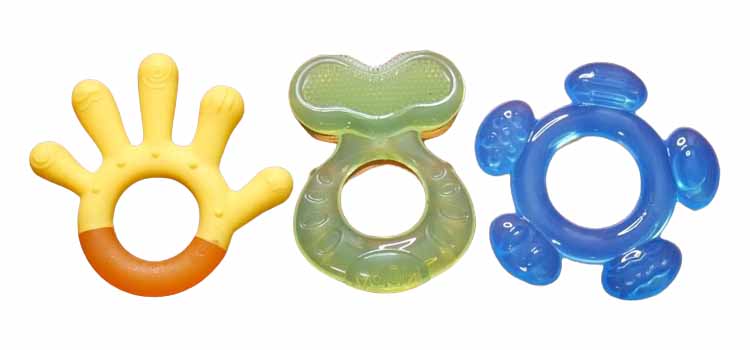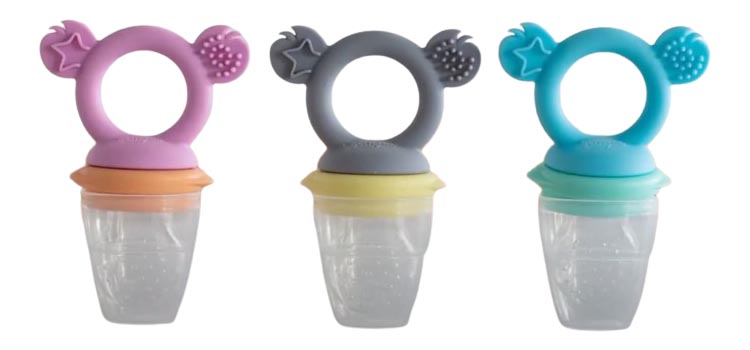As an Amazon Associate I earn from qualifying purchases.
When it comes to soothing a teething baby, many parents wonder, “How many teethers does a baby need?” An important turning point in a baby’s growth is when their first small pearly whites appear during teething. Although this stage is cute, it can cause discomfort and fussiness for parents and babies.
Teethers are incredibly helpful, providing tiny ones with comfort and relaxation throughout this difficult period. But amid all the joy of having a new family member, parents frequently wonder how many teethers are necessary for a newborn.

We will explore this question and review the many aspects to consider when determining how many teethers are best for your little one.
From safety concerns to realistic advice and professional recommendations, we’ll provide the knowledge you need to handle this crucial early childhood care component successfully.
Understanding Teething and Its Challenges
A baby’s first set of teeth erupts during the natural developmental stage of teething. While this process can vary from kid to child, it usually starts at six months of age. For babies, teething presents several difficulties, such as soreness, agitation, and irregular sleep schedules. Babies may suffer pain and tenderness in their mouths as their baby teeth erupt through the gums.
This can result in increased drooling and a strong desire to chew on objects to relieve the discomfort.
Parents must identify the signs of teething to give their children the support and care they need. Common indicators include excessive drooling, fussiness, irritability, and a propensity to bite or gnaw on fingers or toys. Furthermore, some babies may experience increased discomfort during this stage due to swollen or inflamed gums.
Teethers are essential for easing teething discomfort and encouraging oral development in response to these difficulties. They are also a safe and useful tool for newborns to massage their gums and relieve pain. Teethers come in a variety of textures and forms.
Furthermore, grinding your teeth with a teether can produce more saliva, which can help keep your mouth healthy and prevent cavities. Thus, it is imperative for parents and newborns to grasp the significance of teethers so that they can navigate the teething journey with ease and comfort.
Factors to Consider When Choosing Teethers
Safety is the top priority when choosing teethers for your child. To safeguard your baby’s health and well-being, ensure the teethers are devoid of dangerous substances and adhere to strict safety regulations. Choosing teethers composed of non-toxic materials like untreated wood, natural rubber, or silicone devoid of BPA will give you peace of mind that your child isn’t exposed to dangerous things.
The material selection greatly influences tethers’ durability and efficacy. Rubber teethers provide flexibility and durability, whereas silicone teethers are well-liked for their soft, chewy texture. Conversely, wooden teethers offer a natural and environmentally sustainable alternative but must be maintained carefully to avoid splintering.
Considerations such as texture and design are crucial when selecting teethers. Teething toys with a variety of textures can provide more comfort and sensory stimulation for babies, who often turn to textured surfaces for relief. Ergonomic designs that are simple for newborns to grasp and operate improve the entire teething experience.
Finally, consider the teethers’ dimensions and form. Use the right size for your baby’s age and developmental stage to ensure that they are comfortable to hold and manipulate in their small hands. Selecting teethers with various contours and forms can also help target particular oral discomfort spots and offer various sensory experiences.
By carefully weighing these features, you can choose the ideal teethers to ease your baby’s teething discomfort properly.
Determining the Number of Teethers Needed

When deciding how many teethers your infant should have, it’s important to consider various elements specific to your situation. First, remember that every infant is unique, and the required teethers may depend on their preferences and teething patterns. While some newborns could be happy with just one or two teethers, others might gain from having a larger selection.
The amount of teethers that should be kept on hand depends on practical factors, including money, convenience, and hygiene. Having several teethers makes it simple to rotate and clean them, giving your kid access to sterilized, new teethers at all times. Furthermore, keeping extra teethers hidden in various places for on-the-go comfort can be practical.
Finally, seeking advice from pediatricians or specialists in child development can offer insightful information about how many teethers are best for babies. These experts may provide tailored advice based on your baby’s age, teething stage, and specific requirements, assisting you in making decisions that will best support your child through the process.
Tips for Using Teethers Effectively
Parents can employ various tactics regarding teethers to provide their teething infants with the most comfort and relief possible. First, introducing teethers to newborns in a joyful and positive approach increases their likelihood of using and exploring them.
To find out what kind of teether your baby prefers, try presenting a variety of shapes and textures.
When using teethers, it’s important to maintain safety and cleanliness. Use a mild soap and water solution to clean and sanitize teethers regularly, or refer to the manufacturer’s instructions for more detailed instructions. This keeps the teethers safe for your infant to use and helps stop bacteria from growing.
Think about using techniques other than typical teethers to ease the discomfort associated with teething. In addition to using clean fingers to gently massage the gums, cold washcloths or teething rings can help relieve aching gums.
Knowing When to Transition Away from Teethers
Identifying the warning signals that your baby may be ready to stop using teethers as they age and their teething journey continues. The emergence of their permanent teeth is one important clue that the teething stage is almost over.
Furthermore, it can indicate that your child is ready to move on if you realize they are no longer interested in using teethers as a source of comfort or if they seem to be finding other sources of solace.
Making the switch from teethers to something else must be done gradually. Provide calming techniques like holding or softly rocking the person or offering comfort items like pillows or plush animals. Help your infant learn to self-soothe using rhythmic breathing exercises or gentle stroking. This will encourage self-soothing habits.
It’s important to keep stressing dental hygiene habits even after your child has stopped using teethers. Use a baby toothbrush or soft cloth to clean their teeth and gums for routine oral hygiene. As they become older, start introducing them to age-appropriate dental hygiene practices.
By continuing to pay attention to their cues and giving them continuous care, you may facilitate your baby’s easy transition away from teethers and support their general dental health and well-being.
FAQs(How Many Teethers Does A Baby Need)
Depending on the baby’s preferences and teething tendencies, various teether toys are necessary. While some newborns could be happy with just one or two teethers, others might gain from having a larger selection.
Although they are not necessary, baby teethers can be quite helpful for easing the discomfort associated with teething and encouraging dental development.
Once all of their primary teeth have developed, which normally happens between the ages of two and three, babies can stop using teethers. But even when their permanent teeth erupt, some babies might find comfort in wearing teethers. It’s crucial to keep an eye on your baby’s teething development and wean them off of teethers gradually.
Other strategies to consider include using cold washcloths, teething rings, and lightly rubbing your gums with clean fingertips. Try out a variety of possibilities to determine what your baby responds to the best.
When babies begin to exhibit indications of teething between the ages of 3-6 months, they can be given teething toys. However, every baby is different, so it’s essential to observe your baby’s readiness and consult with your pediatrician if needed.
Conclusion(How Many Teethers Does A Baby Need)
As we get to the end of our investigation into “how many teethers a baby needs,” it is clear that there isn’t a universally applicable response. As an alternative, it’s critical to consider several variables, including personal preferences, usefulness, and professional advice.
Parental guidance in selecting and using teethers can guarantee that their children have a happy teething experience.
As we end, let us not forget that a baby’s teething adventure represents an important developmental turning point. By providing teethers and other appropriate materials, parents and children can reduce discomfort, enhance oral health, and feel more secure.
Amazon and the Amazon logo are trademarks of Amazon.com, Inc, or its affiliates.
Leave a Reply